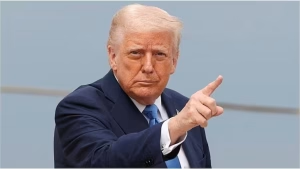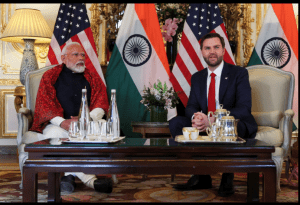New Delhi : In a rapidly shifting global order, U.S. Vice President JD Vance’s high-profile visit to India is seen as a pivotal diplomatic mission. Arriving in New Delhi on Sunday evening, Vance, accompanied by his Indian-origin wife Usha Vance and their three children, is expected to hold wide-ranging talks with Indian Prime Minister Narendra Modi, senior cabinet officials, and business leaders in a bid to reset the tone of Indo-U.S. relations amid escalating trade tensions driven by the Trump administration’s new tariff regime.
🧭 A Trip Laden with Strategic and Symbolic Weight
This marks Vance’s first official visit to India as Vice President, though it carries the weight of far more than just diplomacy—it’s a strategic recalibration at a time when Washington is pursuing economic nationalism under President Donald Trump’s second term. With proposals like a 10% blanket tariff on all U.S. imports and a 60% tariff on Chinese goods, the global economic landscape is shifting, and India is emerging as a key strategic player in that new equation.
Analysts have described the visit as “a balancing act between diplomacy and damage control,” with the U.S. looking to preserve strong bilateral ties while India recalibrates its exports, trade dependencies, and tech industry concerns.
🧾 Agenda Highlights: What’s on the Table?
1. Trade Realignment & Bilateral Agreements
Indian officials are hoping to negotiate tariff exemptions or relaxed duties on key sectors such as textiles, pharmaceuticals, automotive components, and software services. India is also lobbying for renewal of the GSP (Generalized System of Preferences) benefits that Trump had revoked during his first term.
“We’re approaching this with optimism but clarity—we want mutually beneficial trade that also respects India’s role in global value chains,” said a senior official from India’s Ministry of Commerce.
2. H-1B and Skilled Migration Policy
With nearly 70% of all H-1B visas awarded to Indian nationals, any U.S. immigration reform deeply impacts India’s IT and STEM sectors. Vance’s visit aims to assure New Delhi that reforms will not restrict high-skilled labor mobility.
3. Defense Procurement & Joint Manufacturing
Discussions are also expected on joint defense manufacturing, co-development of next-gen drones, and deals involving the Indian Air Force’s modernization program. Vance will meet with Indian Defence Minister Rajnath Singh to discuss deepening interoperability between U.S. and Indian armed forces.
4. Indo-Pacific and Maritime Security
With increasing aggression from China in the South China Sea and Indian Ocean, Vance will reaffirm the U.S.’s commitment to the Quad alliance—India, U.S., Japan, and Australia—and support India’s security objectives.
5. Climate, Energy, and Green Tech
While tariffs dominate headlines, both sides are exploring deeper cooperation on renewable energy, carbon markets, and EV infrastructure. India seeks U.S. tech support to scale green hydrogen and smart grid initiatives.
🌏 Why India Matters in the Trump Era
 President Trump’s push to re-shore American manufacturing and rebalance global trade has strained ties with China and the European Union. Against this backdrop, India emerges as a geopolitical counterweight—not only in Asia, but globally.
President Trump’s push to re-shore American manufacturing and rebalance global trade has strained ties with China and the European Union. Against this backdrop, India emerges as a geopolitical counterweight—not only in Asia, but globally.
“The U.S. cannot afford to lose India as a partner. It’s not just about trade—it’s about trust in a time of fragmentation,” said a Brookings Institution report ahead of the visit.
Moreover, India’s rapidly growing consumer market, digitally literate workforce, and neutral foreign policy stance make it an indispensable ally for American interests.
🕌 Cultural Diplomacy and Personal Connect
Adding a softer diplomatic tone, JD Vance’s itinerary includes a personal visit to Jaipur for a family event and later to Agra’s Taj Mahal. Usha Vance, a Chennai-born attorney, has deep cultural ties with India, and her presence symbolizes the personal dimension of this partnership.
These gestures aim to strengthen “people-to-people connections” between the world’s largest and oldest democracies, reinforcing a sentiment of shared values.
🗣️ Business Leaders and Think Tanks React
-
The Confederation of Indian Industry (CII) called the visit “timely,” urging policymakers to establish a clear framework for technology transfer and ease of doing business.
-
Indian tech firms, notably Infosys and TCS, are watching the visa negotiations closely.
-
Defense experts see this as a “prelude to deeper logistical alignment” under the BECA and LEMOA defense agreements.
🧠 Broader Implications for the Region
Vance’s visit is also seen as a signal to South Asia and Southeast Asia that the U.S. is reinforcing its strategic presence in the region—especially at a time when China’s economic influence is expanding.
📅 What’s Next?
Sources indicate a possible state visit by President Trump to India later this year, potentially during the Quad Leaders’ Summit. There are also discussions on a bilateral mini trade deal that could be announced before the U.S. Presidential elections in November.
Conclusion:
JD Vance’s visit to India is not just a routine diplomatic engagement—it reflects a profound recalibration of priorities in U.S. foreign policy and a recognition of India’s growing influence in the global order. At a time when the world is witnessing a rise in protectionism, trade nationalism, and multipolar power centers, the United States is visibly leaning into its relationship with India as a strategic counterweight to China and an essential economic and democratic partner.


-
Reaffirmation of shared democratic values and people-to-people ties, underlined by Vance’s familial connection to India through his wife, Usha Vance.
-
Recalibration of trade and immigration policies, with India seeking clarity on tariffs, market access, and the mobility of skilled workers in the tech sector.
-
Realignment of security cooperation, especially in the Indo-Pacific, where India and the U.S. are working to build a secure, rules-based maritime architecture.
As the Trump administration aggressively pushes for reshoring and tariff restructuring, India is navigating its path carefully—balancing global competitiveness with national interest. In this context, JD Vance’s visit becomes a diplomatic tightrope walk, seeking to maintain the momentum of previous strategic dialogues while managing new economic frictions.
What emerges is a nuanced relationship—no longer solely defined by aid, trade, or immigration—but shaped by deeper cooperation in defense manufacturing, AI and green tech, space collaboration, and resilient supply chains.
For both countries, the stakes are high. For India, it’s about securing favorable trade terms and technological partnerships; for the U.S., it’s about reinforcing alliances in a fragmented world. In an age of great power competition, India and the U.S. are poised not just to be partners—but pivotal actors steering the future of global governance.
This visit, therefore, is not just diplomatic choreography—it may well be the inflection point that defines the next decade of U.S.-India relations.
Official Press Note from the U.S. Embassy in India.
For more real time updates, visit Channel 6 Network.

